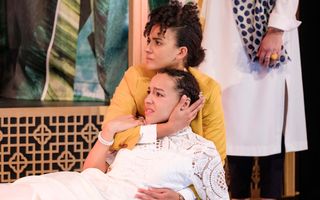Shakespeare relied on two sources to write the play – Ludovico Ariosto’s Orlando Furioso and Matteo Bandello’s La Prima Parte de le Novelle.
Much Ado About Nothing was first performed in 1598 or 1599, either at The Curtain, north of the city of London, or possibly at the newly built Globe (1599). Like most of Shakespeare’s plays, Much Ado About Nothing is based on, or inspired by, pre-existing material. In this case, Shakespeare relied on two sources – Ludovico Ariosto’s Orlando Furioso and Matteo Bandello’s La Prima Parte de le Novelle.
Ariosto’s story is set in Scotland and is told from the point of view of the maid, Dalinda (Margaret in Shakespeare’s play). Dalinda is servant to Genevra, the daughter of the King of Scotland. Dalinda’s lover, Polynesso, convinces Dalinda to dress up like Genevra and make love to him. Little does she know that the intended audience of the spectacle is Ariodante, a rival knight to Polynesso, who is in love with Genevra.
Bandello’s novella is set in Messina, like Much Ado About Nothing, and features a wealthy knight, Sir Timbreo (the equivalent of Shakespeare’s Claudio) a courtier of King Piero of Aragon. Sir Timbreo falls in love with Fenicia, the daughter of Lionato de’ Lionati. Sir Timbreo’s comrade Sir Girondo is also in love with Fenicia and decides to ruin Sir Timbreo’s courtship by deceiving him, in much the same way Claudio is deceived in Much Ado About Nothing.
As usual, Shakespeare takes his sources and alters them, heightening and focusing the drama. Much Ado About Nothing’s Messina has a far more nuanced sense of rank and social hierarchy than its predecessors. Also, in the deception of Claudio, Shakespeare shifts the source of the slander from a rival lover (Polynesso or Sir Girondo) to a disgruntled villain, Don John. The Don John character in the original is romantically interested in Hero, whereas Shakespeare removes that motive. Shakespeare’s Don John’s motives, then, are more murky than a simple love rivalry.
The character of Claudio is far quicker to judge his betrothed than either Ariodante or Sir Timbreo and his reaction is very public. Bandello’s Sir Timbreo politely sends a message to Lionato prior to the wedding to tell him it’s off. Claudio waits almost until ‘I do’ and then shames Hero in front of everyone.
The most important addition by Shakespeare is the relationship of Benedick and Beatrice. The source for those two characters is less clear and they are likely to be largely Shakespeare’s invention. Benedick and Beatrice’s witty dialogue and the very contemporary trajectory of their relationship makes them a favourite of modern audiences. They have clearly relegated Claudio and Hero’s story to the sub-plot. In creating Benedick and Beatrice, this feuding pair who end up together, Shakespeare inspired a romantic comedy trope that has been employed by writers ever since. We see it in Pride and Prejudice, Beauty and the Beast, Star Wars, When Harry Met Sally, and many more.
Also of note is that this play was the last in which Shakespeare wrote a particular type of clown or Fool. The character of Dogberry was originally played by actor Will Kempe, a member of Shakespeare’s troupe, The Lord Chamberlain’s Men. Kempe was a gifted comic clown and dancer, playing such Shakespearean Fools as Falstaff, Bottom and Dogberry. It is believed that Kempe may have enjoyed improvising, to the frustration of his fellow actors. Much Ado About Nothing premiered in 1598, and soon after, Kempe left the Lord Chamberlain’s Men, Dogberry being his final Shakespearean role. Shakespeare changed the way he wrote his Fool characters after Kempe’s departure, exploring more intelligent, wise, witty Fools, rather than bumbling clowns better suited to Kempe’s performances.





